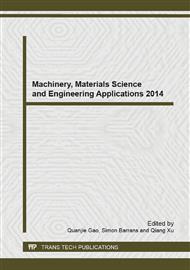p.128
p.132
p.136
p.140
p.144
p.148
p.153
p.159
p.163
Structural Design and Analysis of Abrasive Disk for Biplane of Multiple Workpieces
Abstract:
The planetary lapping is an effective method to improve the precision and efficiency, to obtain the ideal grinding trajectory by changing the planetary structure on the basis of the traditional abrasive mechanism. In order to grinding double plane of multi workpieces at the same time, first the design specific analyze the trajectory, Then, the planetary grinding structure is designed according to the processing requirements, and finally, the trajectory of the lapping is simulated by the kinematics and geometry, in order to verify its availability. The grinding machine is not only has a high machining accuracy and machining quality, but also is simultaneously used in the multiple workpieces having different cross-section within a certain size, in addition, it improves the processing efficiency and reduces processing costs. tables etc.
Info:
Periodical:
Pages:
144-147
Citation:
Online since:
June 2014
Authors:
Keywords:
Price:
Сopyright:
© 2014 Trans Tech Publications Ltd. All Rights Reserved
Share:
Citation:


